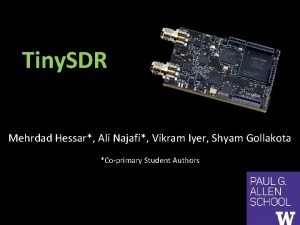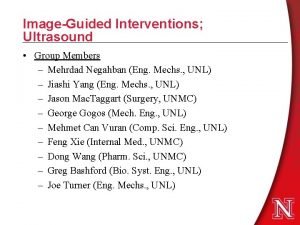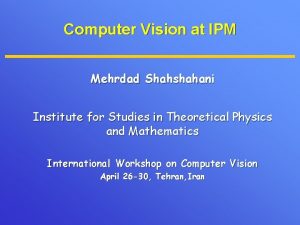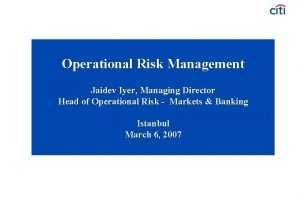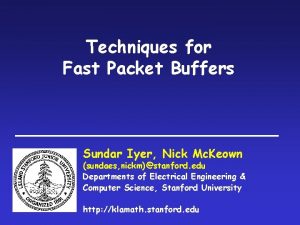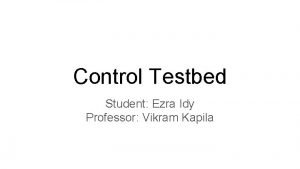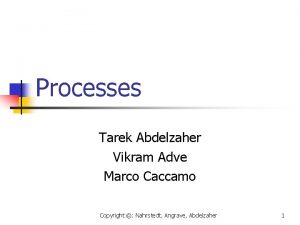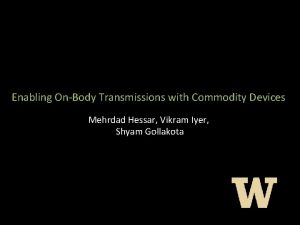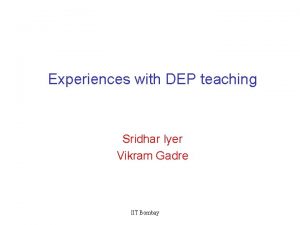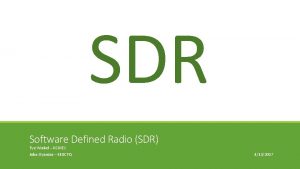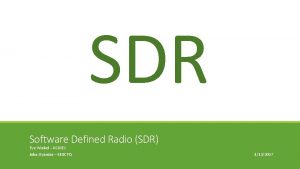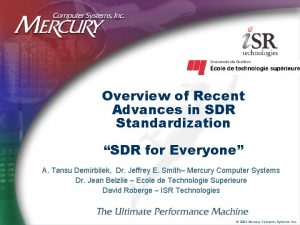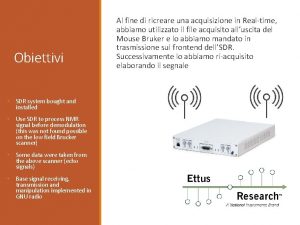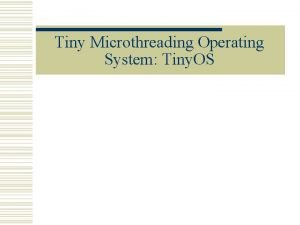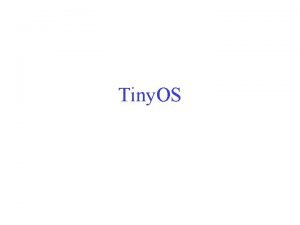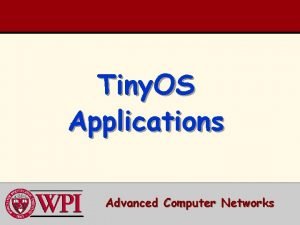Tiny SDR Mehrdad Hessar Ali Najafi Vikram Iyer





















- Slides: 21

Tiny. SDR Mehrdad Hessar*, Ali Najafi*, Vikram Iyer, Shyam Gollakota *Co-primary Student Authors

Io. T Ecosystem is Fast-Changing 2009 2015 2016 2017 ? ? ?

Academic community’s impact has been limited • Each protocol requires a dedicated inflexible chip • Many are proprietary Little room for innovation Can’t easily scale Io. T testbeds or develop new low-power protocols

Ideal Io. T Network Testbed Battery-operated, duty-cycled SDR devices 99 9 999 99 9

SDR must model constraints of Io. T endpoints • Support duty-cycle Ultra-low power sleep mode • Battery-operated Low-power tx/rx mode • Ability to update PHY and MAC over-the-air wirelessly • Support interfaces with sensors

Existing SDRs don’t satisfy these requirements • Sleep power 10000 times too high • Radio module consumes high power for tx/rx Sleep Power Consumption (m. W) 140010000 12001000 N/A N/A RX TX • 1000 Require USB or Ethernet to update firmware 100 800 10 600 1 400 0. 1 200 0. 01 0 F R P P R D R R e S 0 lad R 0 F me R US 3 R 10 P US R 2 P i 0 0 D n i. b i 4 e L 2 S X UES 310 USB 200 blad. 0 ime. M ni B U L Mi 2 E B No TX T R uto l o i D l P to R S u. SD u DR Galio. T l P R S a D u G S R D y. S DR n i T y. S Tin

Tiny. SDR • First low-power SDR platform which supports over-the-air update for PHY and MAC layers • 30 u. W in sleep mode Ø 10000 x lower than existing platforms • Supports 900 MHz and 2. 4 GHz ISM frequency bands, 4 MHz bandwidth and digital/analog sensor interfaces • Has high sensitivities that match custom radio chipsets Ø -126 d. Bm sensitivity for Lo. Ra at 6 Kbps Ø -94 d. Bm sensitivity for Bluetooth beacons

Tiny. SDR Platform Design • Physical layer design • MAC layer design • Over-the-air update

Physical Layer Requirements • I/O supports 4 MHz bandwidth Ø Each I/Q sample 32 bits 128 Mbps • Real-time processing of 128 Mbps data Ø De/modulation running at line rate Achieve these I/O and processing capabilities on a low-power device

Low-Power FPGA for PHY Flash-Based SRAM-Based Sleep Built-in sleep mode Requires shutoff Boot Time 4 -5 ms 20 ms Cost > $40 $5 -6 We use Lattice ECP 5 SRAM-based FPGA Ø Operate FPGA at 64 MHz Ø Has sufficient resources; Lo. Ra Modulator (4%) Demodulator (11%)

Tiny. SDR Platform Design • Physical layer design • MAC layer design • Over-the-air update

FPGA for MAC leads to energy waste Lo. Ra Packet Sleep Rx slot 1 End Device 1 second Base station FPGA ON: wasting 127 m. J Rx slot 2

Our Solution: Io. T MAC on Microcontroller • Enables energy efficient MAC protocol • Consumes only 2μW in sleep mode Ø More than 10000 times less than FPGA Big advantage of programmability Ø C programming vs HDL programming Ø Speed up innovation for MAC researchers

Tiny. SDR Platform Design • Physical layer design • MAC layer design • Over-the-air update

Over-the-Air Update 99 9 999 99 9

Dedicated Backbone Radio • Why dedicated radio? Ø Support fail-safe mode if PHY or MAC layer have issue • Which radio? Lo. Ra Ø Supports long range up to a kilometer Ø Low-power consumption in Rx/Tx modes Challenge: Large FPGA/MCU firmware Ø 570 KB FPGA file takes 14 min at 5 kbps

Our Solution: Compress Chunks of Firmware 1 2 3 4 Microcontroller Memory . . . 3 4 2 1 Compression FPGA 1 2 3 4 Flash . . .

Over-the-Air Update: Evaluation

Over-the-Air Update: Evaluation FPGA: Lo. Ra FPGA: BLE MCU: Lo. Ra/BLE 1 CDF 0. 8 0. 6 0. 4 0. 2 0 0. 5 1 1. 5 2 2. 5 Duration (minutes) 3 3. 5 4 Update Lo. Ra 2100 times and BLE 5600 times

Tiny. SDR Architecture Physical Layer FPGA 2. 4 GHz I/Q Sub-GHz I/Q Microcontrolle r MAC Protocols Flash Sensor Controller ADC DAC VMCU Lo. Ra Radio Over-the-Air Programming Power Management [30 μW] VFPGA VBat . . . VPA

Tiny. SDR • First low-power SDR platform which supports over-the-air update for PHY and MAC layers • 30 u. W in sleep mode Ø 10000 x lower than existing platforms • Supports 900 MHz and 2. 4 GHz ISM frequency bands, 4 MHz bandwidth and digital/analog sensor interfaces • Has high sensitivities that match custom radio chipsets Ø -126 d. Bm sensitivity for Lo. Ra at 6 Kbps Ø -94 d. Bm sensitivity for BLE beacon
 Mehrdad hessar
Mehrdad hessar Mehran najafi
Mehran najafi Mehran najafi
Mehran najafi Mehran najafi
Mehran najafi Mehrdad r. kermani
Mehrdad r. kermani Mehrdad negahban
Mehrdad negahban Mehrdad shahshahani
Mehrdad shahshahani Elijah serrano
Elijah serrano Electrical energy
Electrical energy Jaidev iyer
Jaidev iyer Raj lyer
Raj lyer Dr sridhar iyer
Dr sridhar iyer Gopalkrishnan iyer
Gopalkrishnan iyer Sridhar iyer iit bombay
Sridhar iyer iit bombay Erik ganesh iyer søegaard
Erik ganesh iyer søegaard Vishakh g iyer
Vishakh g iyer Nick iyer
Nick iyer Vikram shakkottai
Vikram shakkottai Vikram kapila
Vikram kapila Vikram mukherjee
Vikram mukherjee Vikram vijayaraghavan
Vikram vijayaraghavan Marco caccamo
Marco caccamo
